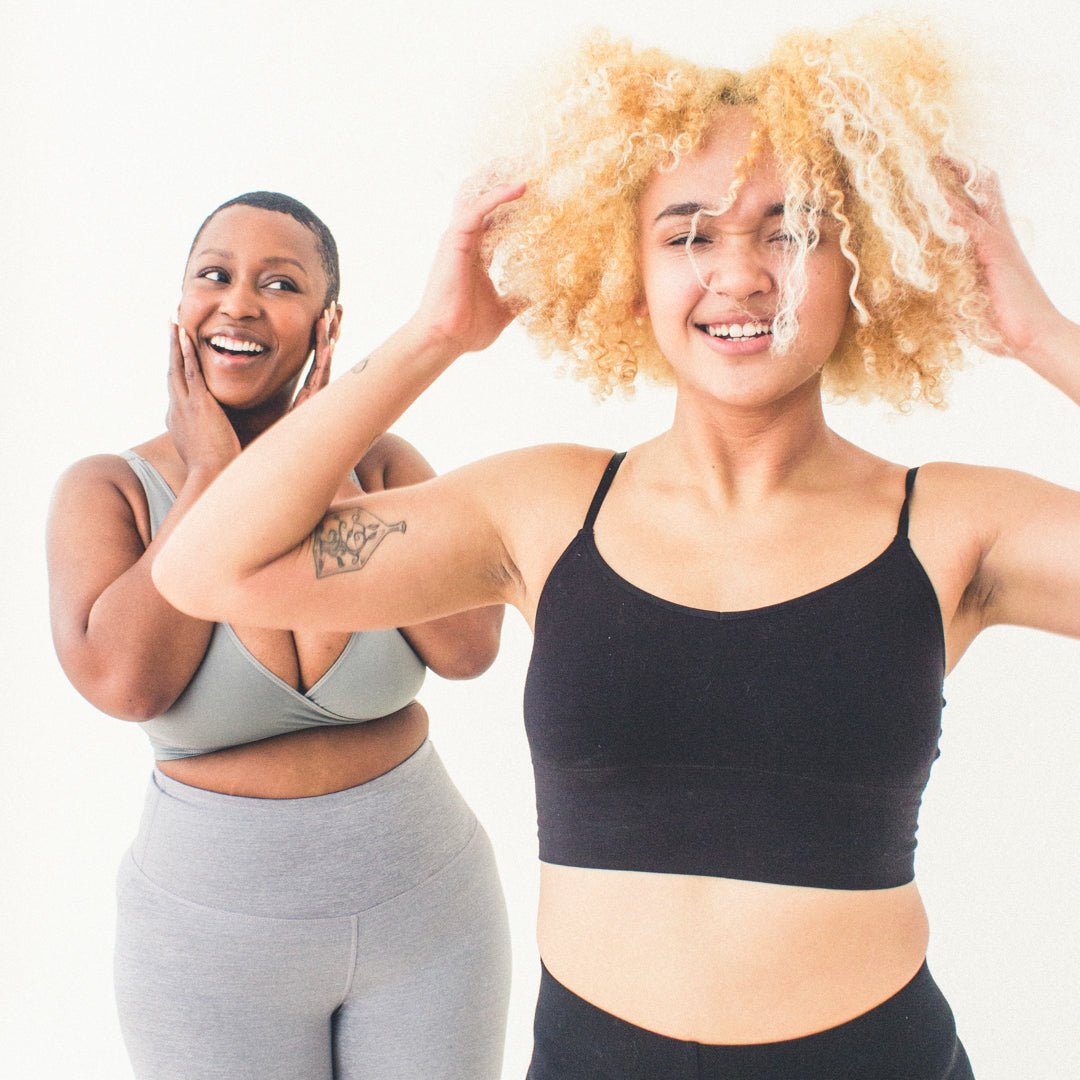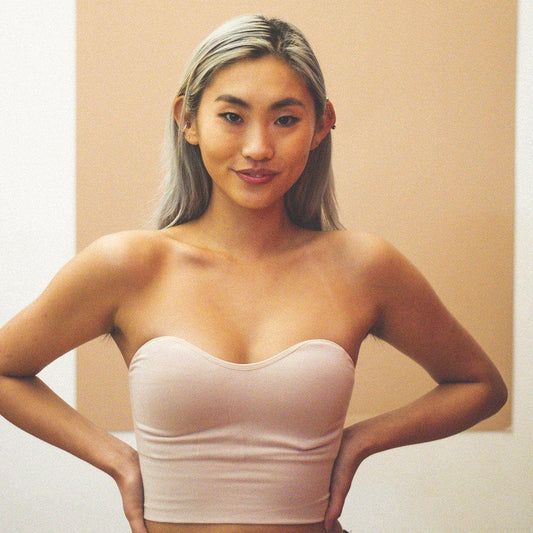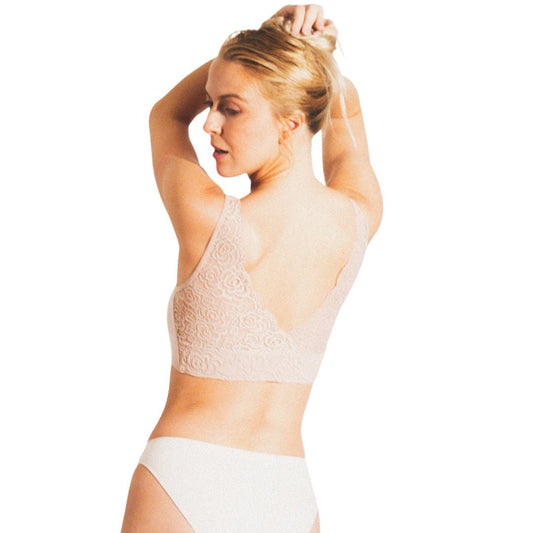
From A to DDD: Understanding the Different Bra Sizes and What They Mean
Welcome to the world of bra sizes, where the alphabet holds the key to finding the perfect fit! Whether you're a petite A cup or a curvaceous DDD, understanding the different bra sizes can revolutionize your lingerie game. It's not just about aesthetics - finding the right size can enhance your comfort, support, and overall confidence. But with so many letters and numbers to decipher, it's easy to get lost in the bra-size maze. That's why we're here to guide you through it all.
In this comprehensive guide, we'll demystify the world of bra sizes, breaking down what each letter and number means, and how they impact your bra shopping experience. Get ready to embrace your curves and discover the perfect fit that will make you feel fabulous, no matter your cup size!
The importance of wearing the right bra size
Wearing the right bra size is more than just a matter of aesthetics – it's about your comfort and well-being. Many women underestimate the impact of an ill-fitting bra on their daily lives. A bra that's too tight or too loose can cause discomfort, pain, and even long-term health issues. The right bra size provides the necessary support for your breasts, helping to alleviate back and shoulder pain, improve posture, and prevent sagging.
When you wear a bra that fits properly, it enhances your body shape and boosts your confidence. It can make your clothes fit better, improve your posture, and even change the way you carry yourself. The right bra size can also enhance your body image, allowing you to embrace your curves and feel more comfortable in your own skin. So, it's not just about the numbers and letters – it's about finding the perfect fit that makes you feel like the best version of yourself.
Understanding bra sizing and measurements
Bra sizing can be a confusing concept, but it's essential to understand how it works to find the right fit. Bra sizes consist of a combination of letters and numbers which represent the band size and cup size. The band size refers to the measurement around your ribcage, just below your breasts, while the cup size indicates the volume of your breasts.
Band sizes are typically measured in inches, ranging from 28 to 54 or more, depending on the brand. Here at BRABAR, we have Band Sizes 28-40. On the other hand, cup sizes are represented by letters from A to DDD and beyond. Each letter corresponds to a specific difference in breast volume, with an A-Cup being the smallest and a DDD-Cup being one of the largest cup sizes available. It's important to note that cup sizes are not static – the cup sizes change when the band size changes. For example, a 34D has a larger cup volume than a 32D.
Common misconceptions about bra sizes
There are several common misconceptions when it comes to bra sizes that can lead to confusion and frustration. One of the most prevalent misconceptions is that an A-cup is the smallest size and a D-cup is the largest. In reality, cup sizes are relative to the band size, so a 32A is smaller than a 36A, even though they both have an A-Cup. Another misconception is that the D-Cup is considered large, when in fact, it's just an average-to-fuller bust size.
It's also important to note that the letter itself does not determine the size of the breasts. The cup size is a relative measurement that represents the difference between the bust circumference and the underbust circumference. So, a woman with a 34D cup size may have a different breast size compared to another woman with the same cup size.
Understanding these misconceptions can help remove the stigma and pressure associated with bra sizes and allow for a more accurate understanding of one's own body.
Different bra size systems around the world
While the most widely recognized bra size system is the one used in the United States, there are different size systems used around the world. For example, in the UK, bra sizes are typically represented by letters from A to K, with K being one of the largest cup sizes available. In Europe, the band size is measured in centimeters, and the cup size is represented by letters from A to I. It's important to note these differences when purchasing bras internationally or online.
Additionally, some brands may have unique sizing systems, which can further complicate the bra shopping experience. It's always advisable to refer to the brand's size guide or consult a professional fitter to ensure the best fit. Understanding the different bra size systems can help you navigate the options available to you and ensure a more accurate fit.
Exploring the A to DDD/F bra size range
Now that we have a better understanding of bra sizing and measurements, let's explore the A to DDD/F bra size range in more detail. The A cup is the smallest cup size available, often suited for individuals with smaller breasts or those who prefer a more natural and minimalistic look. As we move up the alphabet, the cup volume increases, providing more coverage and support.
The D cup, often associated with a fuller bust, is considered one of the larger cup sizes. However, it's important to remember that cup sizes are relative to the band size, so a 32D will have a different volume compared to a 38D. The DDD cup, also known as an F cup in some sizing systems, is even larger and offers more support for those with a fuller bust.
It's worth noting that the A to DDD range is not exhaustive, and there are larger cup sizes available beyond DDD. These sizes are often referred to as "extended sizes" and are designed to accommodate individuals with a fuller bust. It's essential to have a wide range of sizes available to cater to the diverse needs and preferences of women.
How to measure your bra size accurately
Measuring your bra size accurately is crucial for finding the perfect fit. While it's always recommended to have a professional fitting done, you can also measure yourself at home using a measuring tape.
To measure your band size, wrap the tape snugly around your ribcage, just below your breasts, ensuring it's parallel to the ground. Take note of the measurement in inches, round to the nearest even whole number.
Next, measure your bust size by wrapping the tape around the fullest part of your breasts, making sure it's level and not too tight. Take note of this measurement as well to the nearest whole number.
To calculate your cup size, subtract your band size from your bust size. For example, if your band size is 34 inches and your bust size is 38 inches, the difference is 4 inches, which corresponds to a D-Cup.
It's important to remember that these measurements are just a starting point, and trying on bras in different styles and sizes is crucial to finding the perfect fit.
Additionally, factors like breast shape, tissue density, and personal preferences can all impact how a bra fits and feels. Don't be discouraged if you have to try on several bras before finding the right one – it's all part of the journey to finding your perfect fit.
Signs that you may be wearing the wrong bra size
Wearing the wrong bra size can have a significant impact on your comfort and well-being. Here are some signs that you may be wearing the wrong bra size:
1. **Band riding up**: If the band of your bra rides up your back, it's a sign that it's too big. The band should sit horizontally and snugly around your ribcage, providing support without digging in or riding up.
2. **Cup spillage**: If your breasts are spilling out of the cups or creating a "double boob" effect, it's a sign that the cups are too small. The cups should fully encase your breasts without creating any bulges or discomfort.
3. **Straps digging in**: If your bra straps are digging into your shoulders, it's a sign that your bra may not be providing enough support. The majority of the support should come from the band, not the straps.
4. **Gapping cups**: If there's a noticeable gap between your breasts and the cups of your bra, it's a sign that the cups are too big. The cups should lay flat against your breasts, with no gaps or wrinkles.
5. **Overall discomfort**: If you constantly feel uncomfortable or find yourself adjusting your bra throughout the day, you're likely wearing the wrong size. A well-fitting bra should be comfortable and supportive, allowing you to go about your day without any distractions.
Finding the right bra for your shape and style preferences
Finding the right bra goes beyond just the size – it's also about finding the right style and shape that complements your body. Different bra styles offer varying levels of support and coverage, and it's important to choose a style that suits your needs and preferences.
For individuals with smaller breasts, bralettes and push-up bras can provide a natural-looking lift and enhance the bust. T-shirt everyday bras are a great option for everyday wear, as they offer a smooth and seamless appearance under clothing.
For those with a fuller bust, bras with underwire and wider straps can provide additional support and minimize discomfort.
When it comes to style preferences, there's a wide range of options to choose from at BRABAR. From laceback bralettes and embroidery to cami bra tops with bold colors to classic everyday bras to racerback bras to medium-impact sports bras to stylish halter bralettes to comfy strapless bras to crop bras to multiway convertible bras, BRABAR bras can be a reflection of your personal style and mood. We have options! Bras for teens, tween bralettes, and bras for women over 20!
Don't be afraid to experiment and try different styles – you might be surprised at what suits you best.
Tips for bra shopping and trying on bras
Bra shopping can be a daunting task, but with these tips, you'll be well-prepared to find the perfect fit:
1. **Know your measurements**: Before you start shopping, measure yourself accurately to have a starting point for your size. Keep in mind that sizes can vary between brands, so it's essential to refer to each brand's size guide.
2. **Try different styles**: Don't be afraid to try on different styles and shapes to find what works best for you. What may work for someone else may not necessarily work for you, so keep an open mind and be willing to experiment.
3. **Seek professional fitting**: If possible, visit a lingerie store and get a professional fitting. The expertise of a fitter can help guide you towards the right size and style for your body.
4. **Consider your wardrobe**: Think about the types of clothing you usually wear and choose bras that will work well with your wardrobe. For example, if you often wear low-cut tops, a plunge bra may be a better option.
5. **Trust your instincts**: Ultimately, the most important factor in finding the right bra is how it feels on you. Trust your instincts and choose a bra that makes you feel comfortable, supported, and confident.
The impact of wearing the right bra size on comfort and confidence
Wearing the right bra size can have a profound impact on your comfort and confidence. A well-fitting bra provides the necessary support for your breasts, minimizing discomfort and pain. It allows you to move freely and go about your day without any distractions.
In addition to physical comfort, wearing the right bra size can also boost your confidence. When you feel supported and comfortable in your underwear, it translates into how you carry yourself and interact with the world. The right bra size can enhance your body shape, improve your posture, and make your clothes fit better, ultimately boosting your overall confidence.
Understanding the world of bra sizes is the key to finding the perfect fit that will make you feel fabulous, no matter your cup size. It's important to remember that bra sizes are not static – they change in relation to the band size and can vary between different brands and sizing systems. By measuring yourself accurately, trying on different styles, and trusting your instincts, you can find the right bra that provides the support, comfort, and confidence you deserve. Embrace your curves, explore the options available, and enjoy the transformative power of a well-fitting bra.
The Proper Fit: Beyond A to DDD
As you continue on your journey to finding the perfect bra, it's crucial to recognize that getting the correct fit is about more than just knowing your size—it's about understanding how your body and lifestyle can influence that size over time. Your body isn't static; it's constantly changing due to factors like weight fluctuations, exercise routines, and even hormonal changes. That's why regularly updating your bra size and ensuring a proper fit is essential for comfort and confidence.
Does Your Size Surprise You?
If the size you received after measuring surprised you, you're not alone. Many women experience changes in their bra size due to various factors such as weight gain or loss, new exercise regimens, pregnancy, or diet fluctuations. It's also important to note that even small changes in your body can alter the size you require. This is where "sister sizes" come into play—alternative sizes where the band size changes slightly while maintaining a similar cup volume. However, these sister sizes can sometimes lead to an imperfect fit, as they might be too large in the band area and too small in the cup, resulting in unnecessary discomfort.
When It's Time to Get a Fitting: Signs of a Bad Fit
Even if you think you've found the right bra size, it's essential to re-evaluate every 6 to 12 months. Our bodies change, and so do our needs for support. Here are some signs that your bra might no longer be the right fit:
If any of these issues sound familiar, it might be time to reassess your bra size or seek a professional fitting. You can also learn how to measure yourself accurately with our Fitting Guide and Bra Size Calculator, designed to help you find your true size from the comfort of your home.
A-Cup Bras: Embrace Your Natural Shape
A-cup bras are ideal for those with smaller breasts who seek a natural, minimalistic look. These bras often come with light padding or no padding at all, providing a comfortable fit without adding extra bulk. BRABAR’s Everyday Convertible Bra with a J-Hook is a good option with light padding. The Soft Cami Bra Top, the Soft V Crop Top Bra, and the Soft Multiway Convertible Bralette are all good bralettes, cami bra tops, or crop top bras with no pads. Explore our collection of A-Cup bras at BRABAR to find styles that celebrate your natural shape.
B Cup Bras: Balance and Comfort
B-cup bras offer a balance of support and shape without overwhelming your frame. This cup size is versatile and can accommodate various styles, from bralettes to push-up bras. The Everyday Push-Up Bra with a J-Hook is a great option. For bralettes, you could go with a lace bralette like the Soft V Laceback Reversible Bralette or the HUG Lace Halter Bra. At BRABAR, we have a wide range of B-Cup bras designed to enhance your comfort while providing the lift and support you need.
C Cup Bras: Versatility in Style
C-cup bras are perfect for those who want a versatile option that can transition from day to night. This size offers enough coverage and support while still allowing for flexibility in style. Whether you prefer a seamless t-shirt everyday bra like the Soft Everyday Bra with Back Closure or something more daring such as a reversible lace bralette like the Soft V Laceback Reversible Bralette, our C cup collection has you covered!
D Cup Bras: Fuller Support
D-Cup bras provide ample support for fuller busts, helping to distribute weight evenly and reduce strain on your back and shoulders. These bras often feature wider straps for additional stability like the Everyday Scoop Neck Bra and the Soft Day Bra with Back Closure. Discover our range of D-Cup bras at BRABAR that offer both style and comfort.
DD/E Cup Bras: Enhanced Comfort and Style
DD and E cup bras, which are the same cup size in US size, are designed for those who need extra support without sacrificing style. These bras typically come with reinforced bands and cups to ensure a secure fit. At BRABAR, we offer a variety of DD and E-cup bras that combine comfort with a fashionable edge. I suggest the Soft Day Bra with Back Closure, the Soft Crop Bra, and the Soft V Crop Bra as good everyday bra options and crop top bra options. For something with more flare, the Soft V Reversible Lace Bralette is top-notch!
DDD/F Cup Bras: Maximum Support
DDD and F cups, which are the same cup size in US-sizing, bras are engineered to provide maximum support for larger busts. These bras often include additional features like side panels to help maintain shape and comfort throughout the day. Explore our selection of DDD and F cup bras at BRABAR to find your perfect fit. The Soft V Reversible Lace Bralette, Soft Day Bra with Back Closure, Soft Crop Bra, Everyday Scoop Neck Bra, and the Soft V Crop Bra are wonderful options.
Shop with Confidence
At BRABAR, we're committed to helping you find the perfect bra that meets your needs. Our wide selection of sizes, styles, and expert resources make shopping easier and more enjoyable. Browse our collection at BRABAR today and experience the difference that a well-fitting bra can make.
By using these tools and guides, including our Fitting Guide and Bra Size Calculator, you'll not only understand your size better but also gain the confidence to choose bras that make you feel amazing every day. Embrace your curves, enhance your comfort, and elevate your confidence with the right bra from BRABAR.




